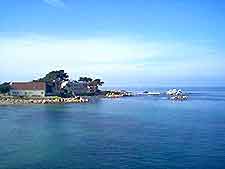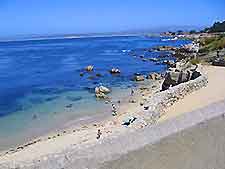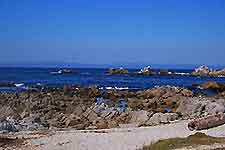Monterey History Facts and Timeline
(Monterey, California - CA, USA)

The small and culturally-rich Californian town of Monterey is blessed with a superb setting on the bay of the same name. This town is of particular historical importance due to its position as capital of Alta California under
Mexico and
Spain, during the troubled years between 1777 and 1846.
Traditionally a fishing town, for the last 100 years or more it has attracted many noted artists and authors, such as Henry Miller, John Steinbeck and Xavier Martinez.
Ancient Settlements
Monterey's colonial history was a continuation of an ancient hunter-gatherer settlement in this biologically-rich region, with various Native American tribes living here for several thousand years. A branch of the Ohlone tribe divided their time between settled coastal summers, living off the fruits of the sea, and inland nomadic winters, hunting and collecting acorns for grinding into flour. The slow death of their way of life commenced when, in 1602, mariner Sebastian Vizcaino landed in the bay and claimed the land for Spain.

Colonial Times
By the 1770s, Franciscan missions had been established in the region, with the tribespeople forced into labor or banished to reservations, and in 1774, the small settlement was named the capital of upper and lower California. Two years later, a Spanish expedition brought more colonists together with 240 soldiers, who were ordered to 'keep the peace'. By 1820, with the little town expanding outside its walls, with adobe and stone houses, Mexico gained independence from colonial Spain. At this time, a customs house was established in Monterey to deal with traders exchanging hides and tallow for luxury goods.
The Gold Rush and Cannery Row Days
Following the Mexican-American War, which ended in 1846, Monterey and California reverted back to the United States, with the town's economy and population boosted by the discovery of gold nearby in 1848. A year later, it lost its position as capital to
San Jose. Now a successful commercial fishing port, Monterey was welcoming Chinese fishermen and Portuguese shore whalers to its community by the 1850s. In 1874, a small local railroad arrived, although its effect on the growing town's economy wasn't as magical as expected.
Expansion occurred only when the major Southern Pacific Railroad finally reached the town in the late 19th century, bringing luxury hotel developments and establishing Monterey as an immigration hub for Japanese and Sicilian fishing concerns, with canneries starting up as a result, and a US Army base constructed. During WWI, Monterey's canneries and fishing industry became crucial for the war effort, replacing already established tourism as a major earner for the town.

Del Monte and the 21st Century
Immediately post-war, developer Sam Morse opened his cannery on the famous Cannery Row and founded the Del Monte Company. By the early 1940s, Monterey was nicknamed the 'Sardine Capital of the World', with Japanese-Americans owning over half of the fishing fleets moored at Fisherman's Wharf. Sadly, in 1942, all Japanese-Americans living in the region were forced into detention camps inland and were not released until the end of WWII. By the end of the 1950s, the sardine industry had collapsed due to overfishing.
In the present day, Monterey is an upscale haunt for wealthy residents and a getaway destination for San Francisco urbanites, as well as a tourist hub for visitors from Europe and Asia. Visitors come for its heritage buildings, art and culture, charming harbor and spectacular eco-rich coastline - a far cry from its humble beginnings.
 The small and culturally-rich Californian town of Monterey is blessed with a superb setting on the bay of the same name. This town is of particular historical importance due to its position as capital of Alta California under Mexico and Spain, during the troubled years between 1777 and 1846.
The small and culturally-rich Californian town of Monterey is blessed with a superb setting on the bay of the same name. This town is of particular historical importance due to its position as capital of Alta California under Mexico and Spain, during the troubled years between 1777 and 1846.
